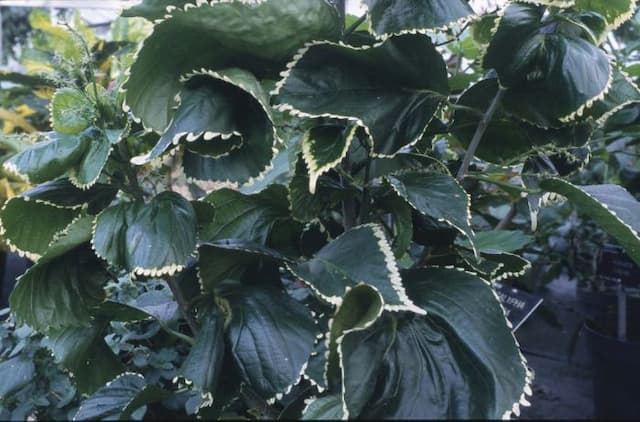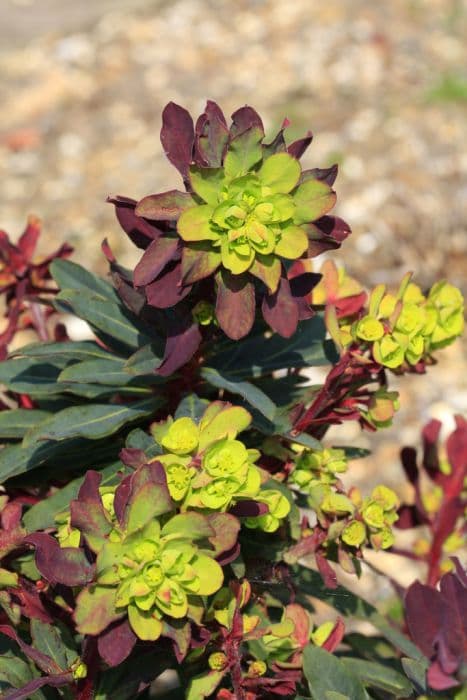Mediterranean Spurge Euphorbia characias subsp. wulfenii 'Lambrook Gold'

ABOUT
Euphorbia characias subsp. wulfenii 'Lambrook Gold', commonly known as spurge, is a striking perennial that boasts a robust, bushy form. Its foliage is a vibrant green with a distinctive golden edge that adds a splash of color to the garden throughout the year. The leaves are narrow, oblong, and arranged in a spiral pattern along the stems, creating a dense and textured appearance. During the flowering season, spurge produces abundant rounded clusters of small, cup-shaped flowers. These blooms are a vibrant shade of greenish-yellow and have a unique, eye-catching structure with tiny central petals surrounded by colorful bracts that resemble petals themselves. The contrast between the golden-edged leaves and the flowers creates a showy display that can enliven any planting area. The overall visual impact of spurge is one of structure and color, with its foliage persisting to give year-round interest even when the plant is not in bloom. It is often admired for its ease of care and its ability to provide a long season of interest due to both its foliage and its distinctive flower heads. It fits well in a variety of garden settings, from borders to rockeries, and it pairs beautifully with other plants to create a diverse garden tapestry.
About this plant
 Names
NamesFamily
Euphorbiaceae.
Synonyms
Mediterranean Spurge, Wulfen's Spurge, Lambrook Gold Spurge.
Common names
Euphorbia characias subsp. wulfenii 'Lambrook Gold'
 Toxicity
ToxicityTo humans
Mediterranean Spurge, like other Euphorbias, contains a milky sap that is toxic to humans. If ingested, it can cause severe irritation to the mouth, throat, and stomach, leading to symptoms such as nausea, vomiting, and diarrhea. Contact with the skin can result in dermatitis, rashes, and burns, especially if the sap is not washed off quickly. If the sap comes into contact with the eyes, it can cause pain, redness, and even temporary blindness. Always handle Euphorbia characias subsp. wulfenii 'Lambrook Gold' with care and wash your hands thoroughly after any contact.
To pets
Mediterranean Spurge is toxic to pets as well. The milky sap contains toxic compounds that, if ingested, can cause similar symptoms to those in humans, including vomiting, diarrhea, and drooling. In severe cases, ingesting the plant can lead to more serious conditions such as weakness, lethargy, and incoordination. Contact with the skin can cause irritation, redness, and swelling, while eye contact might result in conjunctivitis or corneal damage. Care should be taken to prevent pets from accessing or ingesting any part of this plant.
 Characteristics
CharacteristicsLife cycle
Perennials
Foliage type
Evergreen
Color of leaves
Blue-green
Flower color
Yellow-green
Height
3-4 feet (0.9-1.2 meters)
Spread
2-3 feet (0.6-0.9 meters)
Plant type
Shrub
Hardiness zones
8
Native area
Mediterranean
Benefits
 General Benefits
General Benefits- Ornamental Value: Euphorbia characias subsp. wulfenii 'Lambrook Gold', commonly known as Mediterranean Spurge, has eye-catching chartreuse-yellow flowers that add color and visual interest to gardens.
- Drought Tolerance: Mediterranean Spurge is extremely drought-tolerant, making it ideal for xeriscaping and low-water gardens.
- Low Maintenance: It requires very little maintenance, making it a good choice for gardeners who have limited time for plant care.
- Deer Resistance: This plant is typically resistant to deer, which can be particularly useful in areas where deer predation is a problem.
- Long Blooming Season: It has a long blooming period that is often from early spring to summer, providing a long season of visual interest.
- Architectural Shape: The upright, columnar form adds an architectural element to the landscape, providing structure and contrast.
- Attracts Pollinators: The flowers attract beneficial insects like bees, which are important for pollinating gardens and supporting local ecosystems.
 Medical Properties
Medical PropertiesThis plant is not used for medical purposes.
 Air-purifying Qualities
Air-purifying QualitiesThis plant is not specifically known for air purifying qualities.
 Other Uses
Other Uses- Textile Dyeing: The sap of Mediterranean Spurge can be used as a natural dye for fabrics, providing a range of yellow to green hues, depending on the mordant used.
- Photography: The plant's milky sap contains complex compounds that can be used in alternative photography processes, such as anthotype, to create plant-based prints.
- Landscaping: 'Lambrook Gold' is specifically cultivated for its ornamental value, with striking foliage that can be used in xeriscaping for its drought-resistant properties.
- Erosion Control: Due to its extensive root system, Mediterranean Spurge can be planted on slopes and in areas prone to erosion to help stabilize the soil.
- Ink Production: The sap, when reduced and mixed with other components, can be used to make natural inks for art and calligraphy.
- Fish Poison: Historically, some species of Euphorbia sap were used to poison water in small ponds to stun fish, making them easier to catch. This practice is not recommended due to environmental concerns.
- Wood Polish: Beeswax polish can be infused with the sap or extracts to enhance the polish's effectiveness and provide a unique fragrance to finished wooden surfaces.
- Garden Companion Planting: Its distinct look and structure can be beneficial in companion planting, helping to highlight the colors and shapes of surrounding plants in a garden setting.
- Protective Barrier: The plant's toxic sap and spiky appearance can function as a natural barrier to deter animals and intruders from a property or specific garden areas.
- Creative Arts: Dried stems and flowers can be used in floral arrangements or as part of art installations due to their unique architectural form.
Interesting Facts
 Feng Shui
Feng ShuiThe Mediterranean Spurge is not used in Feng Shui practice.
 Zodiac Sign Compitability
Zodiac Sign CompitabilityThe Mediterranean Spurge is not used in astrology practice.
 Plant Symbolism
Plant Symbolism- Protection - Many Euphorbia plants exude a milky sap that can be irritating to the skin and toxic if ingested, which gives them a symbolic meaning of protection against harm and negative influences.
- Perseverance - Euphorbias are known for their hardiness and ability to thrive in harsh conditions, symbolizing the trait of perseverance and overcoming challenges in life.
- Purification - Some cultures historically believed that Euphorbias could purify the air and protect against disease, lending them a symbolic meaning of purification and cleansing.
- Healing - Although the sap is irritating, Euphorbia has been used in traditional medicine, symbolizing healing power and the dual nature of things that can harm or cure.
 Water
WaterMediterranean Spurge should be watered infrequently but deeply, generally once every one to two weeks depending on the climate and weather conditions. It's essential to allow the soil to dry out between waterings to prevent root rot. A good method is to water the plant at the base, avoiding overhead watering, with about one gallon for mature plants during the growing season if there has been no substantial rainfall. In winter, reduce watering significantly, allowing the plant to receive only natural precipitation if possible, unless the weather is exceptionally dry and warm.
 Light
LightMediterranean Spurge thrives in full sun locations where it can receive at least six hours of direct sunlight each day. It can tolerate some light shade, especially in the hottest part of the afternoon, but its flowering might be reduced in too much shade. The best spot for the plant would be in a south-facing or west-facing position where it can enjoy uninterrupted sunlight.
 Temperature
TemperatureMediterranean Spurge is a hardy plant that can tolerate a wide range of temperatures. It can withstand temperatures as low as 10 degrees Fahrenheit and as high as 90 degrees Fahrenheit. Ideally, the plant prefers to be cultivated where daytime temperatures are between 60 and 75 degrees Fahrenheit. It is frost hardy, but should be protected from severe winter cold and chilling winds.
 Pruning
PruningMediterranean Spurge should be pruned to remove spent flowers and to maintain its shape. The best time for pruning is after the plant has finished flowering, usually in late spring or early summer. You can also remove any damaged or diseased stems at this time. Prune the flowered stems back to the base or to a fresh growth point to encourage new growth and a bushier habit. It's usually not necessary to prune the plant more than once a year.
 Cleaning
CleaningAs needed
 Soil
SoilMediterranean Spurge thrives in well-draining, sandy, or gravely soil with some organic matter. Best soil mix includes two parts sand or gravel, one part peat or compost, and one part regular garden soil. Maintain a soil pH between 6.0 and 7.5 for optimal growth.
 Repotting
RepottingMediterranean Spurge should be repotted every 2 to 3 years or when it outgrows its current container. Use a pot that is one size larger to ensure adequate room for root growth.
 Humidity & Misting
Humidity & MistingMediterranean Spurge prefers a dry climate and does not require high humidity levels. It is tolerant of low humidity often found in typical household environments.
 Suitable locations
Suitable locationsIndoor
Ensure full sun, well-draining soil, and minimal watering.
Outdoor
Plant in full sun, well-drained soil; water sparingly.
Hardiness zone
7-10 USDA
 Life cycle
Life cycleEuphorbia characias subsp. wulfenii 'Lambrook Gold', also known as Mediterranean Spurge 'Lambrook Gold', begins its life cycle when seeds are sown in well-drained soil, typically after the last frost for outdoor plantings. As a perennial, the plant emerges each spring, producing upright stems and whorls of blue-green leaves with yellow variegation ('Lambrook Gold'). In late winter to early spring, flower heads composed of cup-shaped bracts containing small actual flowers called cyathia develop at the stem tips, displaying a striking chartreuse color. After pollination, which can be facilitated by insects, the plant sets seed, which may be dispersed by wind or gravity. Mediterranean Spurge 'Lambrook Gold' then goes through a period of dormancy during the hot summer months, where parts of the plant may die back but the root system remains alive. The following year, the cycle restarts with new shoots from the rootstock, as this plant is long-lived and will continue to re-emerge for several years before it may require division or replacement.
 Propogation
PropogationPropogation time
Spring-Early Summer
Propogation: For the Euphorbia characias subsp. wulfenii 'Lambrook Gold', also commonly known as Mediterranean Spurge, the most popular method of propagation is through seed sowing. The best time for sowing seeds is in spring, after the last frost when the soil begins to warm. Seeds should be sown in well-draining soil, lightly covered with soil, and kept moist until germination occurs. It's important to provide bright light but avoid direct sunlight which may be too intense for the young seedlings. The seedlings can be transplanted once they are large enough to handle, usually when they have developed a couple of sets of true leaves. Care should be taken when handling Euphorbia due to its sap, which can be an irritant to skin and eyes, so wearing gloves is recommended during the process.



![Spurge [Blackbird]](/_next/image?url=https%3A%2F%2Fplants-admin.emdemapps.com%2Fimages%2Fplants%2F%2Fimages%2F604b535f37783.png&w=640&q=75)





